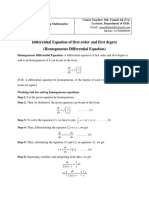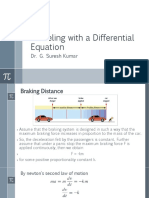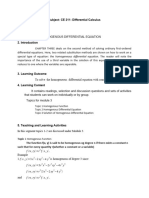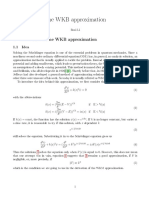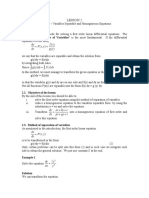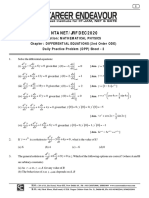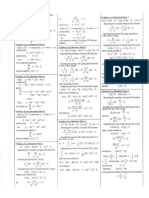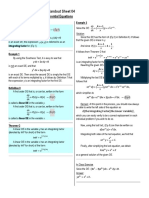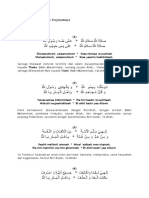Math 3342 HS03
Math 3342 HS03
Uploaded by
Andrew AlarconCopyright:
Available Formats
Math 3342 HS03
Math 3342 HS03
Uploaded by
Andrew AlarconOriginal Title
Copyright
Available Formats
Share this document
Did you find this document useful?
Is this content inappropriate?
Copyright:
Available Formats
Math 3342 HS03
Math 3342 HS03
Uploaded by
Andrew AlarconCopyright:
Available Formats
Differential Equations 1 – Handout Sheet 03
Solving First Order Homogeneous Differential Equations
Definition 6 Using the substitution v y x to return to the original
The differential equation variables, we get
M(x , y) dx N(x , y) dy 0 y2
x 6 (3 2 1) K .
is called a homogeneous differential equation when x
M( x , y) dx N( x , y) dy Simplifying the last equation, we find that
can be rewritten as 3x 4 y2 x 6 K
n [M(x , y) dx N(x , y)dy] 0 .
is a general solution of the given DE.
Theorem B
When M(x , y) dx N(x , y) dy 0 is a homogeneous DE, Example 2
the substitutions y vx and x vy both transform the given
Solve the BVP: (y x2 y2 )dx x dy 0, y(4) 3.
homogeneous DE into a variables separable DE.
Solution:
Since
Example 1
(y ( x)2 (y)2 )dx ( x) dy 0,
Solve the DE: (x 2y )dx xydy 0.
2 2
can be rewritten as
Solution:
Since
[(y x2 y2 )dx x dy] 0,
[( x)2 2(y)2 ]dx ( x)(y) dy 0 Definition 6 tells us that the given DE is homogeneous.
So, Theorem B tells us that the substitution
can be rewritten as
y vx , which implies that dy v dx x dv ,
2 [(x2 2y2 )dx xydy] 0,
transforms the given DE into a variables separable DE.
Definition 6 tells us that the given DE is homogeneous.
Applying the above substitutions to the given DE, we get
So, Theorem B tells us that the substitution
y vx , which implies that dy v dx x dv , (vx x2 v2 x2 )dx x(v dx x dv) 0,
transforms the given DE into a variables separable DE. which simplifies to
Applying the above substitutions to the given DE, we get (vx x 1 v2 )dx xv dx x 2 dv 0,
(x2 2v2 x2 )dx x(vx)(vdx xdv) 0,
x v 2 1 dx x 2 dv 0,
which simplifies to
and finally after separating the variables to
(1 2v2 )dx v(vdx xdv) 0, 1 1
dx dv 0. ←(Eq.1)
(2v2 1)dx v2 dx vxdv 0, x v 1
2
(3v2 1)dx vxdv 0,
and finally after separating the variables to Note: with v tan (and thus dv sec2 d ), we find that
1 1 1 dv sec2 d sec2 d
x
dx ( 2 )(6v) dv 0.
6 3v 1 v2 1
tan2 1
sec2
sec d
Integrating the last equation term by term, we get
ln|sec tan | ln| v2 1 v|.
ln|x|(1 6)ln|3v 1| C ,
2
which simplifies to Now, integrating (Eq.1) term by term, we get
6ln|x| ln|3v 1| 6C D,
2
ln| x |ln| v2 1 v | C ,
6
ln[|x||3v2 1|] D, which simplifies to
|x|
6
| x ||3v2 1| eD E , ln[ ] C ,
|v v 2 1|
x 6 (3v2 1) K.
|x|
eC D , Homework Problems for Handout Sheet 03
|v v 1|
2
1. Solve the DE: (3x 4y) dx (2x y) dy 0.
| x | D|v v 2 1)|,
2. Solve the BVP: (x 4y) dx (5x 2y)dy 0, y (4) 1.
x K (v v 2 1).
3. Solve the DE: (x2 y2 ) dx 5xydy 0.
Using the substitution v y x to return to the original
variables, we get 4. Solve the BVP: 2xydx (3x2 y2 )dy 0, y (6) 2.
y2 y
y
x K ( 2 1 ), 5. Solve the DE: [ x cot( ) y]dx x dy 0.
x x x
which simplifies to Answers:
y x y 2 2
x K( ). 1. (y 3x)5 K(y x).
x x2
After multiplying each term by x, we find that 2. (2y x)2 12(x y).
x2 K( y x2 y2 ) 3. (2y x)5 (2y x)5 Kx2 .
is a general solution of the given DE. 4. x2 y2 5y 3 .
However, since we are solving a BVP, we must find the
y
particular solution of the given DE that satisfies y (4) 3, which 5. x cos( ) K .
x
means that y 3 when x 4. So, it follows from the above
general solution of the DE that
(4)2 K (3 42 32 ), and so K 2.
So, the particular solution of the given DE that also satisfies
the boundary condition y (4) 3 is
x2 2( y x 2 y2 ),
which could be rewritten as
x2 2y 2 x2 y2 ),
(x2 2y)2 4(x2 y2 ),
x 4 4 x 2 y 4y 2 4 x 2 4 y 2 ,
x 4 4 x2 y 4 x2 ,
x2 4y 4,
and finally as
1
y (x 2 4).
4
In Class Exercise
Solve the DE: xydx (y2 x2 )dy 0.
Answer: x2 y2 ln(y2 ) Ky2 .
You might also like
- Getting To Know JestDocument29 pagesGetting To Know JestMahesh VP100% (1)
- EDPM SBA Mark Schemes 2023Document6 pagesEDPM SBA Mark Schemes 2023Janae GarrawayNo ratings yet
- Automated Propeller Generation in GrasshopperDocument39 pagesAutomated Propeller Generation in GrasshopperAbul Kalam Faruk100% (1)
- Mathematics: Quarter IV-Week 1 Learning Activity Sheets (LAS)Document8 pagesMathematics: Quarter IV-Week 1 Learning Activity Sheets (LAS)Florame Algarme Melano100% (1)
- First Order Differential EquationsDocument75 pagesFirst Order Differential EquationsDinicen ViclaraNo ratings yet
- De NotesDocument8 pagesDe Notesjistoni tanNo ratings yet
- Persamaan Pembezaan BiasaDocument86 pagesPersamaan Pembezaan BiasamarNo ratings yet
- Chap3 4Document6 pagesChap3 4Dexter BrianNo ratings yet
- Chapter 4 Homogeneous Differential EquationDocument14 pagesChapter 4 Homogeneous Differential EquationChristian Jay Miano BojosNo ratings yet
- Solution of First Order Differential Equation by Various Method-IiiDocument6 pagesSolution of First Order Differential Equation by Various Method-Iiiadiba adibNo ratings yet
- Variable, Reducible Variable, Homogeneous, Non-HomogeneousDocument21 pagesVariable, Reducible Variable, Homogeneous, Non-HomogeneousParth AnajwalaNo ratings yet
- Differential Equation of First Order and First Degree (Homogeneous Differential Equation)Document8 pagesDifferential Equation of First Order and First Degree (Homogeneous Differential Equation)Ahmed FaysalNo ratings yet
- Rand Mathieu CISMDocument19 pagesRand Mathieu CISMArunachalam BjNo ratings yet
- Homogeneous Differential EquationsDocument21 pagesHomogeneous Differential EquationsWASEEM_AKHTER100% (3)
- Defslt Lec # 04 15-01-21Document5 pagesDefslt Lec # 04 15-01-21AkashNo ratings yet
- unit-10Document5 pagesunit-10venkadeshwaran.rNo ratings yet
- Lec 4 Second Order Linear Differential EquationsDocument51 pagesLec 4 Second Order Linear Differential EquationsTarun KatariaNo ratings yet
- 1 Differential Eqn - Lecture Notes 6: 1.1 Substitution Methods, Homogeneous Equations, Bernoulli Equa-TionsDocument8 pages1 Differential Eqn - Lecture Notes 6: 1.1 Substitution Methods, Homogeneous Equations, Bernoulli Equa-TionsAfs AsgNo ratings yet
- MM ODL 5Document16 pagesMM ODL 5Shakeb RahmanNo ratings yet
- Lesson 12Document4 pagesLesson 12Perumal GovindanNo ratings yet
- First Order DE - 21Document108 pagesFirst Order DE - 21Mehrab RahmanNo ratings yet
- Problem40 43Document1 pageProblem40 43IENCSNo ratings yet
- Assignment 1 - Spring2006: SolutionDocument31 pagesAssignment 1 - Spring2006: SolutionMuhammad UmairNo ratings yet
- Chapter 2 (1st ODE)Document35 pagesChapter 2 (1st ODE)一鸿No ratings yet
- Residual Minimization TechniqueDocument6 pagesResidual Minimization TechniqueHrithik GoyalNo ratings yet
- 2-First-Order Ordinary Differential Equations: y X F DX DyDocument5 pages2-First-Order Ordinary Differential Equations: y X F DX Dyابومحمد المرزوقNo ratings yet
- Defslt Lec # 02 12-01-21Document3 pagesDefslt Lec # 02 12-01-21AkashNo ratings yet
- Solved Problems On de With Homogeneous Coefficient PDFDocument6 pagesSolved Problems On de With Homogeneous Coefficient PDFKenneth Rodriguez HerminadoNo ratings yet
- Ordinary Differential BP106RMTDocument87 pagesOrdinary Differential BP106RMTdhurvchavda4No ratings yet
- GalerkinDocument2 pagesGalerkinAditya UpadhyaNo ratings yet
- Exercises Set 02. Classical Wave EquationDocument5 pagesExercises Set 02. Classical Wave EquationGabo S-bvNo ratings yet
- De Module 3Document7 pagesDe Module 3reyesmannysonNo ratings yet
- Ode PDFDocument81 pagesOde PDFHindi Hindi100% (1)
- Solutions231218 1Document6 pagesSolutions231218 1Катерина ДьомкінаNo ratings yet
- MA201 Tut.5Document1 pageMA201 Tut.5designography02No ratings yet
- LatexDocument5 pagesLatexbbiplab023No ratings yet
- AlbastamiDocument10 pagesAlbastamitarif ashtarNo ratings yet
- MA108-Lecture 2-D3Document21 pagesMA108-Lecture 2-D3Aditya DwivediNo ratings yet
- Integration 2 PDFDocument5 pagesIntegration 2 PDFAbdullah AliNo ratings yet
- qms17 7sDocument9 pagesqms17 7sMarisol Hernández SánchezNo ratings yet
- Diffusion EquationDocument22 pagesDiffusion EquationTaterRayGumfriesNo ratings yet
- 2023 Differential Equations Discussion Solution (CSL)Document15 pages2023 Differential Equations Discussion Solution (CSL)Xin XinNo ratings yet
- Differential Equations: e DX Dy y DX y D XyDocument12 pagesDifferential Equations: e DX Dy y DX y D XycheongjiajunNo ratings yet
- Differential Equations URPDocument26 pagesDifferential Equations URPabcd xyzNo ratings yet
- Osgood Uniqueness TheoremDocument5 pagesOsgood Uniqueness TheoremZPratt StarkNo ratings yet
- 1.2 Homogeneous EquationDocument3 pages1.2 Homogeneous EquationNasir AiyubNo ratings yet
- Ordinary Differential Equations and Real Analysis IDocument3 pagesOrdinary Differential Equations and Real Analysis IV Venkataramana ArchakNo ratings yet
- 2019 H2 JC2 MSM Differential Equations (Solutions)Document15 pages2019 H2 JC2 MSM Differential Equations (Solutions)VincentNo ratings yet
- ODE Notes Lecture 2-4Document49 pagesODE Notes Lecture 2-4manam unguNo ratings yet
- Solutions To Exercise Set 1, TMA4220: September 2, 2015Document5 pagesSolutions To Exercise Set 1, TMA4220: September 2, 2015Salomon HagenimanaNo ratings yet
- Integrating FactorsDocument25 pagesIntegrating FactorsWASEEM_AKHTERNo ratings yet
- Diff &LPP AssignmentDocument3 pagesDiff &LPP Assignmentbalasushim03No ratings yet
- MP DPP Sheet 2Document4 pagesMP DPP Sheet 2Kunish GargNo ratings yet
- Module 4 DE First Order and First Degree Ordinary Differential EquationsDocument7 pagesModule 4 DE First Order and First Degree Ordinary Differential EquationsRodman CajesNo ratings yet
- Cauchy DE Method 11Document20 pagesCauchy DE Method 11ahmadshujaat99proNo ratings yet
- Be 3001 Mathematics 3 Cs It Dec 2017 SolutionsDocument17 pagesBe 3001 Mathematics 3 Cs It Dec 2017 SolutionsSAI KRIPA COMPUTERSNo ratings yet
- First Order Differential EquationDocument15 pagesFirst Order Differential Equationdether acopiadoNo ratings yet
- Maths Class Xii Chapter 09 Differential Equations Practice Paper 11 2024Document3 pagesMaths Class Xii Chapter 09 Differential Equations Practice Paper 11 2024pramiti.gNo ratings yet
- MyanmarDocument15 pagesMyanmarmyothant zawNo ratings yet
- Unit I, Ii, Iii PDFDocument118 pagesUnit I, Ii, Iii PDFSanjana PulapaNo ratings yet
- Linear Equations and Bernoulli EquationsDocument3 pagesLinear Equations and Bernoulli EquationsNazlıcan AkışNo ratings yet
- Green's Function Estimates for Lattice Schrödinger Operators and ApplicationsFrom EverandGreen's Function Estimates for Lattice Schrödinger Operators and ApplicationsNo ratings yet
- Math 3342 HS22Document1 pageMath 3342 HS22Andrew AlarconNo ratings yet
- Math 3342 HS24Document3 pagesMath 3342 HS24Andrew AlarconNo ratings yet
- Math 3342 HS23Document2 pagesMath 3342 HS23Andrew AlarconNo ratings yet
- Math 3342 HS25Document3 pagesMath 3342 HS25Andrew AlarconNo ratings yet
- Differential Equations 1 - Handout Sheet 29: Solving The Heat EquationDocument4 pagesDifferential Equations 1 - Handout Sheet 29: Solving The Heat EquationAndrew AlarconNo ratings yet
- 3342C Unit1 SolutionDocument10 pages3342C Unit1 SolutionAndrew AlarconNo ratings yet
- Math 3342 HS04Document2 pagesMath 3342 HS04Andrew AlarconNo ratings yet
- Homework05 Engineering Thermodynamics MENG 3320: Answer:0.945 KWDocument7 pagesHomework05 Engineering Thermodynamics MENG 3320: Answer:0.945 KWAndrew AlarconNo ratings yet
- Homework03 Engineering Thermodynamics MENG 3320: CP a+bT+cT2+dT3Document5 pagesHomework03 Engineering Thermodynamics MENG 3320: CP a+bT+cT2+dT3Andrew AlarconNo ratings yet
- Health Care Project ReportDocument74 pagesHealth Care Project ReportPattarin UrapevatcharewanNo ratings yet
- SSC GD Books For Exam PreparationDocument3 pagesSSC GD Books For Exam Preparationmail2binduyadavNo ratings yet
- TCS NQT Syllabus PDFDocument9 pagesTCS NQT Syllabus PDFAnonymous 3E7I9SFXnNo ratings yet
- ORM. Lucene. Elasticsearch. Integrated. - Hibernate SearchDocument6 pagesORM. Lucene. Elasticsearch. Integrated. - Hibernate SearchChandu ChandrakanthNo ratings yet
- U2 Chapter 3 Lesson 5 - Doxa N EpistemeDocument24 pagesU2 Chapter 3 Lesson 5 - Doxa N EpistemeLIMUEL AMER ABDULAZIZ PANGANIBANNo ratings yet
- Handout 7 - Gospel of LukeDocument16 pagesHandout 7 - Gospel of Lukewokky77100% (2)
- Resonance Number Theory PrmoDocument38 pagesResonance Number Theory PrmoAyush KumarNo ratings yet
- Entrevista A Silvina BullrichDocument5 pagesEntrevista A Silvina BullrichTania DizNo ratings yet
- Unlock 2e LS3 B1 Unit 5 Health and FitnessDocument22 pagesUnlock 2e LS3 B1 Unit 5 Health and FitnessАнастасия ИвануткинаNo ratings yet
- Egra Grade 2 Pre AssessmentDocument11 pagesEgra Grade 2 Pre AssessmentMlyn CrzNo ratings yet
- Oodj Test1Document4 pagesOodj Test1John WalkerNo ratings yet
- Fay FootprintsDocument2 pagesFay FootprintskoryandcaraNo ratings yet
- The Voter by Chinua AchebeDocument26 pagesThe Voter by Chinua AchebeZeeph 1No ratings yet
- Multi Threading NotesDocument4 pagesMulti Threading NotesNauseeta LalNo ratings yet
- Lesson Plan in Science RPDocument5 pagesLesson Plan in Science RPAmap C. LezieNo ratings yet
- Adept Software Advanced TutorialDocument8 pagesAdept Software Advanced TutorialAnonymous Wu14iV9dqNo ratings yet
- Introduction To Micro Vision KeilDocument10 pagesIntroduction To Micro Vision KeilBollisettiSriharshaNo ratings yet
- Plan Type de Dissertation JuridiqueDocument8 pagesPlan Type de Dissertation JuridiqueOrderPaperOnlineChicago100% (2)
- Garuda Purana ENG Vol 01 OCR Motilal BanasirdassDocument435 pagesGaruda Purana ENG Vol 01 OCR Motilal BanasirdassSiva SundaramNo ratings yet
- syllabus DLDDocument2 pagessyllabus DLD21jg1a05a8.reshmaNo ratings yet
- 1.4: Quadratic Equations: Section OutlineDocument4 pages1.4: Quadratic Equations: Section OutlineAHMED ALSHAMMARINo ratings yet
- Susan Lanser. Toward A Feminist NarratologyDocument10 pagesSusan Lanser. Toward A Feminist NarratologyVictor Finkler LachowskiNo ratings yet
- Teks Sholawat BadarDocument5 pagesTeks Sholawat BadarDzul Fahmi Marjohan100% (1)
- Computation For The Proficiency Level From The Classroom Level To The School LevelDocument3 pagesComputation For The Proficiency Level From The Classroom Level To The School Leveljtxbny100% (6)
- Stroop 1 Lecture Slides (2023-24)Document39 pagesStroop 1 Lecture Slides (2023-24)NusaibahNo ratings yet
- What Do You Like DoingDocument2 pagesWhat Do You Like Doingnovi hutagalungNo ratings yet











